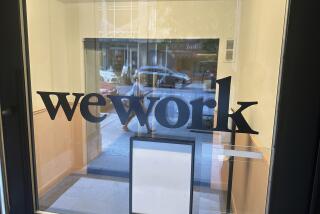MANAGING YOUR MONEY : PREPARE YOURSELF : How to Tell When Your Company Is in Trouble : Patience can pay off because firms usually weather hard times. But it pays to heed signs of trouble that say it’s time to head for the lifeboats.
- Share via
You don’t have to wait until your paycheck bounces to find out if your company is getting into financial trouble. And you don’t have to quit if it is.
During an economic downturn, many firms tighten their belts, take a hard look at costs, see sales slipping. Take heart: More often than not, firms weather these tough times. But there are still warning signs that indicate that things are indeed in bad shape, and you need to know what they are early enough to decide if you should bail out.
What are the red flags? Experts break them into three basic categories: Dead giveaways, leading indicators and what one business professor calls “little nuances.”
Dead Giveaways
* Becoming a “slow payer” to trade vendors.
“When an employer who used to pay bills at 30 days starts stretching those payables to 45 and 60 days, that’s an indication of real problems with cash flow,” says Ronald S. Orr, a partner in the insolvency practice at Gibson, Dunn & Crutcher in Los Angeles.
How do you find out if your boss is starting to sit on payables?
If you’re in a position of hiring the vendors but aren’t responsible for writing the checks, it will probably be you whom they call to complain.
Or network inside your company to see if there’s a cash bind. The rate at which receivables (what customers owe your company) are paid is usually about the same as the rate the company pays its bills. In other words, no money in, no money out.
* Debt load.
When a company doesn’t have the funds to pay loans, it’s got problems. If you work for a publicly held firm, it’s easy to find out what the debt situation is. Go to the business library at a local university--UCLA has a particularly comprehensive one--and do some research in Standard & Poor’s or Moody’s.
“When a company’s debt rating falls below investment grade, look out,” says Dick Levin, the Phillip Hettleman professor of business at the University of North Carolina in Chapel Hill. Typically, a rating below C may indicate mounting problems.
* Layoffs and firings.
This is an obvious one: Your company isn’t making the money it needs to pay its people.
* A stock price that is falling like a rock.
If investors and analysts are growing wary of your company, maybe you should be too.
* High-ranking management defections.
“These are the people in the second tier,” says R. Emmett Jones, a certified public accountant and teacher in the business department at Mendocino College in Ukiah, Calif. “They are high up enough to have a view of the real financial position of the firm, but they don’t have everything at stake; it’s not their whole life.”
Leading Indicators
* Sales and marketing staff defections.
“They know when competitors are starting to get your customers and they know when your market share is starting to slide,” Jones says.
* Insiders selling stock instead of buying.
This information is readily available in the financial press. If you start to see a lot of your officers and directors selling big batches of their holdings, it may mean that they know something you don’t.
* Freezes in wages and hiring.
This is an early warning that your boss is trying to cut personnel costs. The next step might be a dead giveaway: layoffs and firing.
* The founder kicks himself upstairs and brings someone else in to run the company.
Your boss may just want to retire and go fishing, or he may realize that things have gotten out of control and he needs help desperately. This move is especially indicative when it leads to:
* A striking change in the “personality” or management style of your company.
When a firm goes from paternalistic (lots of company parties, Christmas cards from the boss, pats on the back) to hard-nosed and uptight, watch out. Dick Levin says a sudden spate of “save the paper clips memos” are clues.
Little Nuances
None of these by themselves mean anything. Taken together and accompanied by some of the more tangible signs of trouble, they may mean trouble.
* Cutbacks in continuing education for employees.
* Cutbacks in advertising.
This is a quick-fix place to save when cash is tight, although most experts agree that a firm in trouble should probably advertise more, not less.
* No new machinery; not fixing existing machinery when it breaks until absolutely necessary.
* A general decay in the looks of the office or plant--no fresh paint, dirty carpets, unkempt grounds.
The Bottom Line
What can you do if all factors add up to problems? You need to weigh several factors before deciding to leave.
First, don’t panic. Bankruptcy law provides employees with “priority claims” on the company’s assets of up to $2,000 per worker. Even if your firm goes under, you will probably get paid for work already done, and if your company is in a Chapter 11 reorganization, you can probably stay on staff with a fair amount of confidence. The firm needs you more than ever to emerge from the reorganization, according to Ronald Orr.
Larger firms are required by federal law to provide a 60-day notice of plant closings or provide 60 days’ pay to workers in an immediate plant closing.
Running to the regulators, if the company is public, may strike you as a good idea, but think twice. “What did the company do wrong? It’s not a crime to go bankrupt, and employees have a duty to the company,” Orr says. “Unless you’re sure that there’s something illegal going on, such as with a government contract, you expose yourself to a lawsuit.”
Dick Levin suggests making a list of pros and cons of leaving: Is your pension funded? If your company’s pension plan is “qualified,” and most are, you have some measure of protection. The federal Pension Benefit Guarantee Program backs up your pension much as the Federal Deposit Insurance Corp. backs up bank deposits.
Can you take your pension with you? With some plans, you can.
Are you marketable? Is this a temporary or permanent situation?
If you do decide to leave, make sure that you’re not jumping from the frying pan into the fire. If your entire industry is in a downturn, going across the street to a competitor may be a big mistake. At least your current employer may have some loyalty to you, and he is a known quantity.
Keep in mind that it’s much easier to track information about publicly held firms. Although private firms’ failure rate is about the same as public companies, you have to be a bit more enterprising to keep yourself informed.
More to Read
Inside the business of entertainment
The Wide Shot brings you news, analysis and insights on everything from streaming wars to production — and what it all means for the future.
You may occasionally receive promotional content from the Los Angeles Times.










